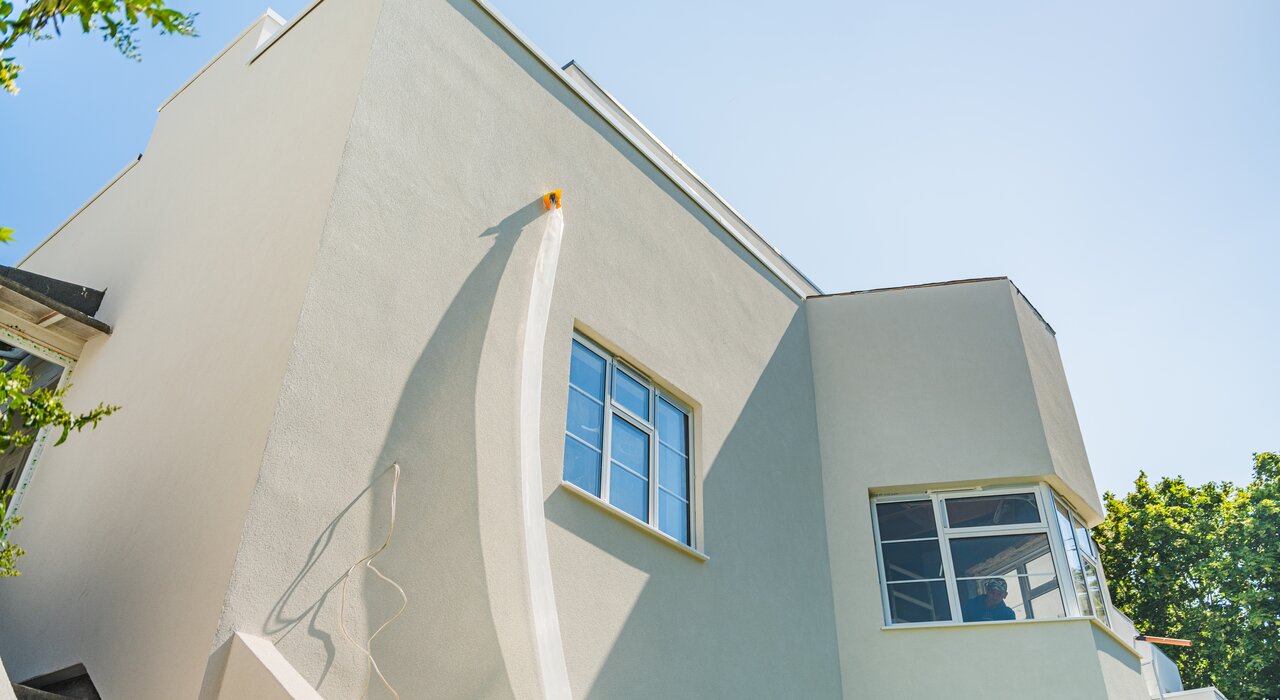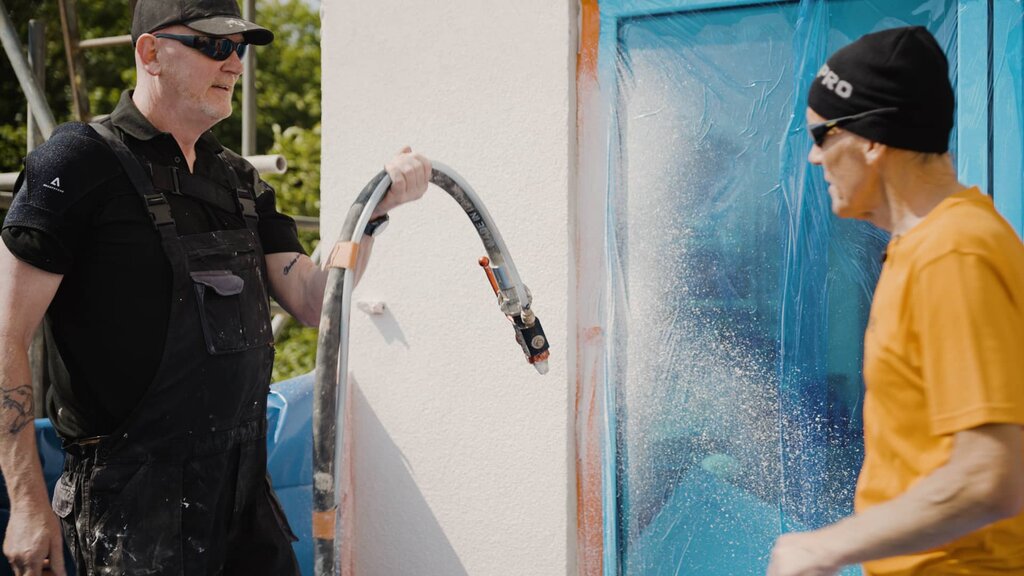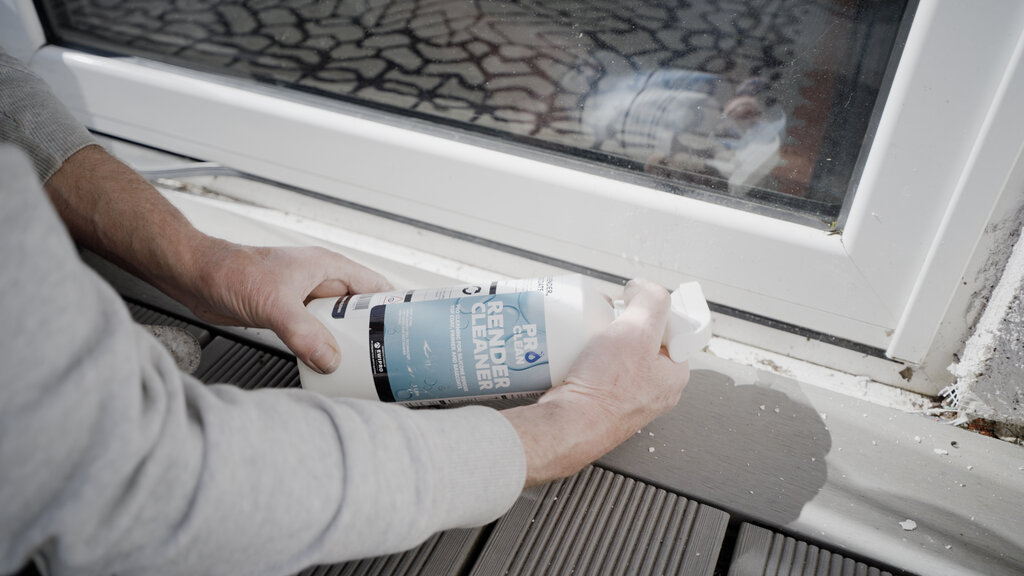
Protecting your project during its rendering and insulation phases is important to ensure the quality and longevity of the final result. Several environmental factors can negatively impact the work if not appropriately managed, such as sun, wind, and rain.
Environmental factors
Different environmental factors like sun, wind, and rain can have significant impacts on the rendering, basecoat, and insulation stages of your project. It's important to understand these effects to mitigate them and ensure a high-quality result.
Sun
The primary concern with sun exposure is that it can cause materials to dry out too quickly. If a render or basecoat dries too quickly, it may not bond properly with the underlying surface, leading to potential cracks and weakening of the structure. This could also lead to an uneven appearance. Additionally, UV radiation from the sun can degrade some materials over time, which can lead to colour fading and structural weakness. However, Silicone Renders are UV-resistant. As such, colour fading is not an issue, and the whole render system can last up to 25 years with minimal maintenance.
Wind
Wind can also contribute to rapid drying of the render and basecoat, leading to similar issues as sun exposure. If the wind blows debris into the wet render, it could stick and become part of the finished surface, causing aesthetic issues and potential weaknesses. Additionally, wind-driven rain can also penetrate structures if not properly protected.
Rain
Rainis probably the most disruptive of the three elements of a rendering project. If the render or basecoat is exposed to rain before it has had a chance to properly set, it can be washed away, resulting in patchy areas or even the failure of the render. Water can also seep behind the render, leading to damage over time. Insulation materials can also get wet, which can drastically reduce their insulating properties and potentially lead to problems like mould growth. To mitigate these effects, it's crucial to protect your work as much as possible. Additionally, try to plan your work around the weather forecast as much as possible - avoid rendering if heavy rain or strong wind is expected, and consider using sunshades or similar temporary structures if intense sun is expected. When working in sunny conditions, ensure that you work ahead of the sun. Regular checks on the work, and quick action if problems are detected, can also help ensure the quality of the final result.
Protect your project - tools and materials
The protective measures available for the project are numerous, all serving a specific purpose.
Tarpaulins
These large, flexible sheets can be made from various materials like polyethene, canvas, or PVC. Heavy-duty, UV-resistant tarpaulins offer the best protection against the sun, rain, and wind. They are designed to withstand harsh conditions, and their UV resistance helps them maintain their structural integrity over time. They come in various sizes to suit different needs and can be fastened using bungee cords or weights, but ensure that the installation doesn't allow wind to lift or move the tarpaulins.
Masking Tape
This adhesive tape is used to shield surfaces from damage or staining. Using a high-quality, weather-resistant type ensures that the adhesive won't fail due to moisture or temperature variations. The tape should be applied firmly but removed carefully to avoid damage to the surface underneath. The best time to remove it is immediately after completing the rendering work to prevent adhesive residues.
Window Film
This is a self-adhesive film applied to glass surfaces to protect against render splashes, dust, and other construction debris. Window film is particularly useful for maintaining visibility while providing protection. It should be applied carefully to avoid air bubbles, which can compromise its protective ability. After the project, the film can be peeled off, leaving a clean, undamaged window underneath.

Fungicidal Wash
This is a type of cleaning solution used to kill fungi, moss, and algae on surfaces before work begins. It's important to follow the manufacturer's instructions, including any recommended dwell times before washing the solution away. This ensures that the treatment is effective in eliminating these biological threats and prevents them from undermining the render's adhesion or growing through it after application.
Render Cleaner
This is a specialised cleaning solution designed to remove stains, spots, and streaks from rendered surfaces. It should be used as directed by the manufacturer. In general, it's best to test the cleaner on a small, inconspicuous area first to ensure it does not discolour the render. It's an essential part of project maintenance, helping to keep the site clean and ensure the highest quality work.
[caption id="attachment_65910" align="aligncenter" width="1024"] https://www.youtube.com/watch?v=ixq-g_2kAHA[/caption]
https://www.youtube.com/watch?v=ixq-g_2kAHA[/caption]
Temporary Downpipes
These are essential if you're working on a property with existing guttering. They help divert rainwater away from the construction site, which can prevent the render from washing off or becoming damaged. They can be made from various materials, such as flexible plastic or even fabric, and are often designed to be easy to install and remove.
Waterproof Membranes
These are often made from bitumen, rubber, or plastic and are designed to provide a barrier against water. They are applied to the surface before insulation and rendering. Their installation is critical and should ensure coverage of all areas, including corners and edges, to prevent water ingress. Membranes also help to prevent issues like dampness and mould, contributing to the overall durability and health of the building.
Sun, Wind, and Rain Protection
Besides the tools and materials mentioned above, specific strategies can be used to protect the project from extreme weather. For example, erecting a temporary structure like a scaffold with sheeting can provide a significant barrier against these elements. In case of high wind conditions, windbreaks or temporary screens could be installed. It's also essential to consider the timing of the work, with periods of lower sun intensity, wind, and no rain being optimal for rendering work. We would always recommend taking every protective measure available to you. An insulation and render project can be expensive, therefore any extra expenses to rectify issues caused by environmental factors should be avoided at all costs. Have you had any issues with protecting your project? Or perhaps had some render crack? Let us know in the comments below and we'll try to help!
